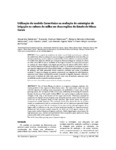Por favor, use este identificador para citar o enlazar este ítem:
http://www.alice.cnptia.embrapa.br/alice/handle/doc/489100| Título: | Utilização do modelo Ceres-Maize na avaliação de estratégias de irrigação na cultura do milho em duas regiões do Estado de Minas Gerais. |
| Autor: | GEDANKEN, A.  MANTOVANI, E. C.   MANTOVANI, B. H. M.   COSTA, L. C.   SANS, L. M. A.   FREITAS, P. S. L. de   |
| Afiliación: | EVANDRO CHARTUNI MANTOVANI, CNPMS. |
| Año: | 2003 |
| Referencia: | Acta Scientiarum Agronomy, Maringá, v. 25, n. 2, p. 439-447, 2003. |
| Descripción: | The Ceres-Maize model was to study water consumption and profitability of maize crop at three growing seasons, for two regions of Minas Gerais, Brazil, for establishing and evaluating the necessary database for the use of this model. Cultivar BR201 was used to evaluate conduction distinct strategies of the crop, at the location of Sete Lagoas and Janauba. Treatments consisted of conduction of irrigated and non-irrigated crops during the growing seasons (15 May to 15 October and 15 December) and two frequency levels of water application: high (central pivot) and medium (conventional sprinkler irrigation). The simulation results have shown that the use of these models as complementary tools to conventional trials and the information presented helped on building the necessary files for simulations. It was observed that although irrigation allows higher yield, its influence on the costs of maize production resulted in a negative economic feedback for both location studied, except for the 10/15 and 12/15 negative season in Sete Lagoas under medium frequency irrigation conditions. Yields irrigated green maize despite the high production costs, showed more profitability when compared to grain production, being economically viable in the majority of treatments.. |
| Thesagro: | Irrigação |
| Palabras clave: | Growing seasons Frequency irrigation |
| Tipo de Material: | Artigo de periódico |
| Acceso: | openAccess |
| Aparece en las colecciones: | Artigo em periódico indexado (CNPMS)  |
Ficheros en este ítem:
| Fichero | Descripción | Tamaño | Formato | |
|---|---|---|---|---|
| Utilizacaomodelo.pdf | 207,9 kB | Adobe PDF |  Visualizar/Abrir |









